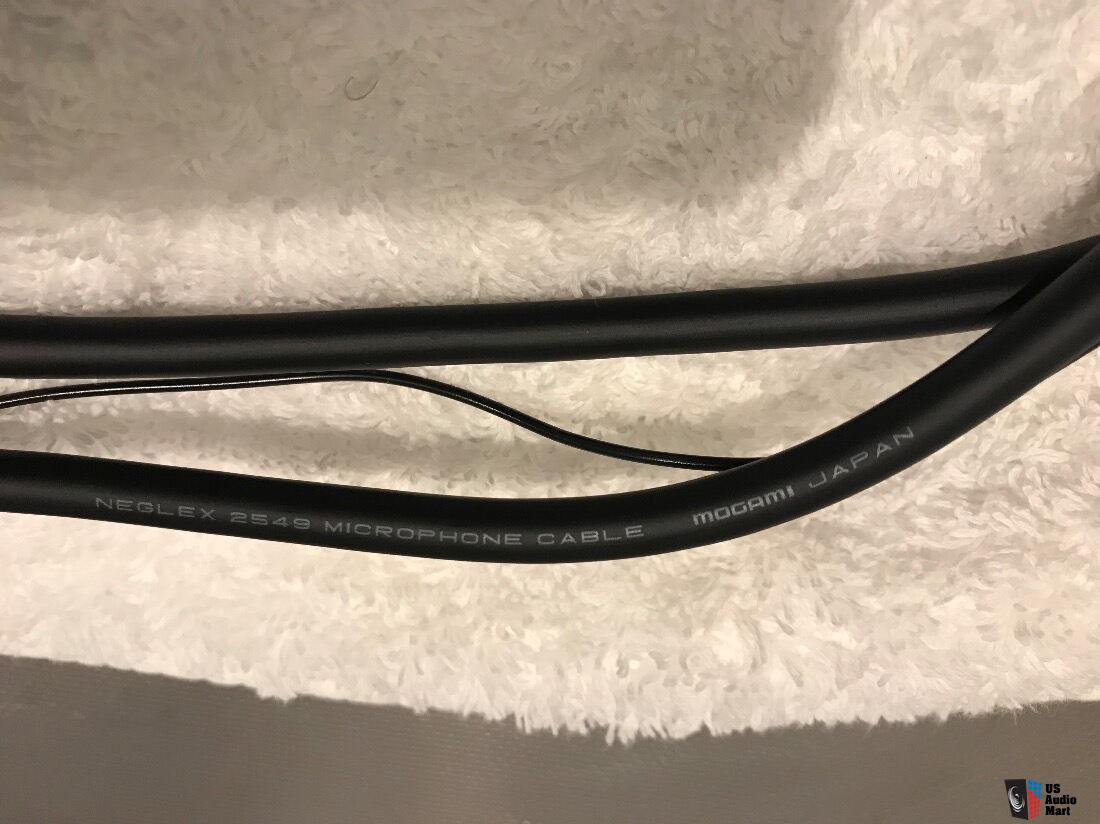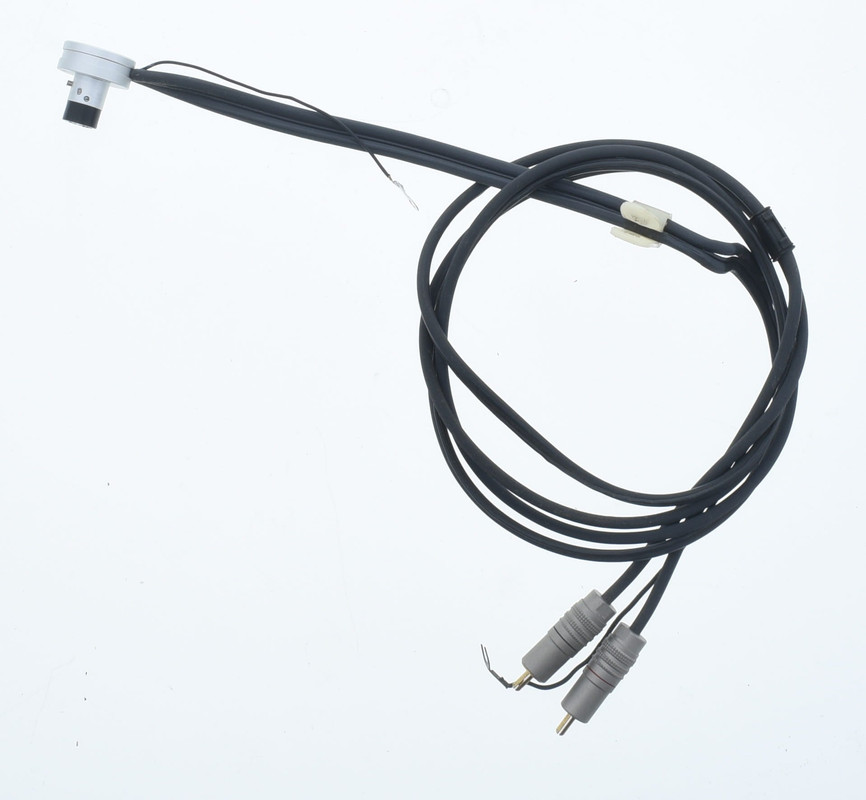You are using an out of date browser. It may not display this or other websites correctly.
You should upgrade or use an alternative browser.
You should upgrade or use an alternative browser.
DIY Linn T Kable - Tonearm Cable
- Thread starter jagdesign
- Start date
Interesting guys - I have some interconnects with 2534, but cannot compare the two. There seems to be consensus elsewhere that the 2549 is preferable in short run, low noise/interference applications - https://gearspace.com/board/so-much...-cable-mogami-2549-standard-vs-2534-quad.html
I'd imagine Linn would've gone for the 2534 if it was noticeably better - perhaps slightly more work to terminate the star quad config?
Anyway, I won't be making another for now!
I'd imagine Linn would've gone for the 2534 if it was noticeably better - perhaps slightly more work to terminate the star quad config?
Anyway, I won't be making another for now!
Craig B
Re:trophile
With these sorts of comparisons, it is important to make clear whether or not one is comparing cables in the context of them being used as tonearm leads vs. standard line level interconnects. If the former, one need also make clear the wiring configuration, especially so, wrt how and where the shield is connected, plus whether one is running MM or MC. Reason being, with all of these mic cables, conductor to shield adds to the cable capacitance, therefore, with MM cartridges in particular, one is likely to notice a difference in top end emphasis if shield is made parallel with signal -ve. With Mogami W2534 quad, for example, the commonly quoted 'self capacitance' of 65pF/m jumps to 110pF/m conductor to shield, therefore, it would be prudent not to parallel shield with signal carrying cores with certain MMs; this especially so, with these being raw cable specs sans the addition of plugs, sockets, and solder connections. This, and we've yet to consider the fact that a 1.2m length of spiral copper shield also makes an inductor.
Last edited:
Paul R
pfm Member
I measured a Linn OEM but not Ittok/Ekos arm cable just now. Pin 2 (centre of DIN) goes to both the earth tag at the pre and the earth tag for the subchassis, no where else. 1 and 4 go to one phono, 5 and 3 to the othe. So the earthing arrangement makes sense (to me) and is counter to the 'truth table' posted upthread which did seem unlikely.
I'll check out a real Ekos cable this evening.
I'll check out a real Ekos cable this evening.
Craig B
Re:trophile
Would this have been the old ridged black insulation co-axial cable, with pale grey plastic angled DIN plug and moulded on red and white RCA plugs?I measured a Linn OEM but not Ittok/Ekos arm cable just now. Pin 2 (centre of DIN) goes to both the earth tag at the pre and the earth tag for the subchassis, no where else. 1 and 4 go to one phono, 5 and 3 to the othe. So the earthing arrangement makes sense (to me) and is counter to the 'truth table' posted upthread which did seem unlikely.
I'll check out a real Ekos cable this evening.
The earthing arrangement appeared normal within the "Old Cable (original supplied with Ittok) basic continuity test" table. It was the suggestion that pins 4 and 5 were somehow linked that seemed unlikely; something that would have necessitated an unlikely to be beneficial link between pins 4 and 5 within the DIN plug.
Or, perhaps you were referring to the convoluted earthing arrangement hinted at within the second 'truth table'.
Regardless, please let us know which 'real Ekos cable' you have, as there appears to have been a few, including this grey coloured co-axial pair with ground wire moulded in between; with the three often separated out post P-clip, as per the pic below. This particular cable saw the transition to the round Linn DIN tin shell sometime prior to the change from OEM co-axial to Mogami mic cable.
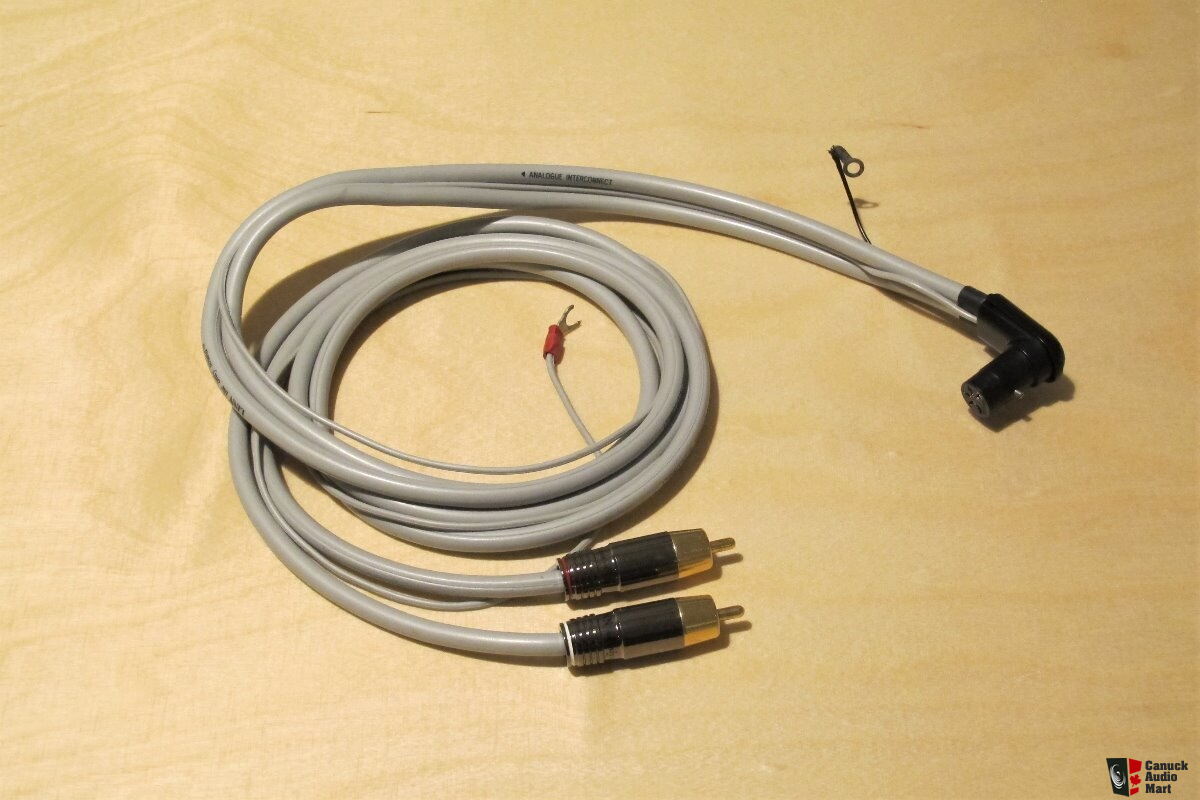
Paul R
pfm Member
The non-Ittok but still Linn cable is from (IIRC) an LVX+, it fits your description of 'ridged black coax, grey DIN' but now has quite nice phonos, I think it may have been through a BNC phase with a previous owner. The genuine Ekos cable came with a genuine Ekos. It is the same coax but has a machined metal DIN that matches the outer width of the arm pillar (similar or identical to the T-Kables pictured up thread) and nice machined silver phonos. It's been through a BNC phase too, but the phonos are the originals. For the record this is also wired as above. The issue with the 'truth table' is that it implies the signal screens are connected to earth by the cable wiring, and this isn't the case with either of my examples. I doubt it's actually the case with the T-Kable either.
Paul R
pfm Member
Almost exactly (see below...). Your trove of cable photos is indeed thorough and extensive.
At some point in the life of mine the bottom cap of the DIN has been removed (and I think lost, unless it's scattered in the LP12 box) and some epoxy poured in. I don't recall actually doing this but I expect it was some sort of LP12 fan word of mouth mod, like unfastening the Ittok arm rest and removing it from the arm board during use. Got quite adept at dropping the arm over the side while changing records.
At some point in the life of mine the bottom cap of the DIN has been removed (and I think lost, unless it's scattered in the LP12 box) and some epoxy poured in. I don't recall actually doing this but I expect it was some sort of LP12 fan word of mouth mod, like unfastening the Ittok arm rest and removing it from the arm board during use. Got quite adept at dropping the arm over the side while changing records.
Craig B
Re:trophile
Can't take credit for the photos; they're just Google images.
Just this morning, I did come across a for sale ad for a T-Kable with bottom cap off and some potting poured in. Seller claimed it was a dealer mod, so who knows how this one started. Seems to defeat what appears to be a designed in cable clamping arrangement via the lid half of the cable aperture biting down into the insulation. I did like those old Linn RCAs though, all that have come since look a bit cheesy in the barrel to moi. I've an old Linn supplied 4 x RCA to XLR5 that came with an LK1 with those early ones on. These at least look and feel the part for the asking price; all that have come since remind me of old Tributaries junk (also ELKA made).
Just this morning, I did come across a for sale ad for a T-Kable with bottom cap off and some potting poured in. Seller claimed it was a dealer mod, so who knows how this one started. Seems to defeat what appears to be a designed in cable clamping arrangement via the lid half of the cable aperture biting down into the insulation. I did like those old Linn RCAs though, all that have come since look a bit cheesy in the barrel to moi. I've an old Linn supplied 4 x RCA to XLR5 that came with an LK1 with those early ones on. These at least look and feel the part for the asking price; all that have come since remind me of old Tributaries junk (also ELKA made).
tomek
pfm Member
With these sorts of comparisons, it is important to make clear whether or not one is comparing cables in the context of them being used as tonearm leads vs. standard line level interconnects. If the former, one need also make clear the wiring configuration, especially so, wrt how and where the shield is connected, plus whether one is running MM or MC. Reason being, with all of these mic cables, conductor to shield adds to the cable capacitance, therefore, with MM cartridges in particular, one is likely to notice a difference in top end emphasis if shield is made parallel with signal -ve. With Mogami W2534 quad, for example, the commonly quoted 'self capacitance' of 65pF/m jumps to 110pF/m conductor to shield, therefore, it would be prudent not to parallel shield with signal carrying cores with certain MMs; this especially so, with these being raw cable specs sans the addition of plugs, sockets, and solder connections. This, and we've yet to consider the fact that a 1.2m length of spiral copper shield also makes an inductor.
I tried 2549 vs 2534 as a tonearm cable (90cm) and as IC in different lenghts. IMHO 2534 is much better, than 2549 in any appliction. We repeated this test with few friends, also doing blind tests and everybody prefers 2534 ... Both cables are so cheap, so anybody can check it.
Cloth Ears
pfm Member
I said in my first post, #10 on this thread, that originally I was going to make a T cable using the Mogami cable for my Ittock but I ended up buying an Ekos SE which came with a Linn supplied Mogami T-cable so I didn't need to in the end.
I posted the pictures in #14 to help identify how the T Cable was constructed from pictures I had downloaded from the various Linny sites. Unfortunately I cannot now find where I got them from especially the Excel sheet showing a connection truth table which I am now convinced is not very truthful at all.
Having muddied the waters by posting what appears to be an erroneous truth table I too would like to get to the bottom of exactly how the screens are connected.
Of course I have my own LP12 with Mogami T cable to measure but I have been reluctant to touch the deck as it was upgraded with Kore, Karousel, Radikal 2, Ekos SE and Kandid about 6 months ago by you know who of Leicester and I don't want to upset the cable dressing etc.
However, to answer the question of are the screens connected to the centre earth pin of the din plug and each other I realised this could be measured from the two phono plugs and the earth lead by simply unplugging from the pre amp.
Here are some pics of the cable which confirms it is definitely constructed from Mogami 2549 and it bears a sticker with what looks like Linn reference numbers for its build spec which I know was manufactured towards the end of 2020.

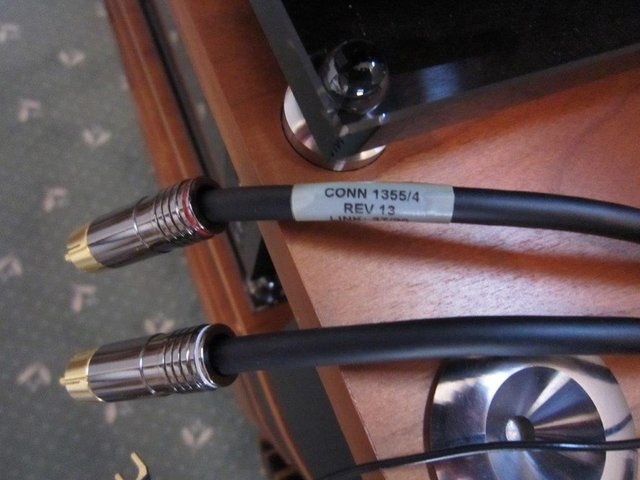
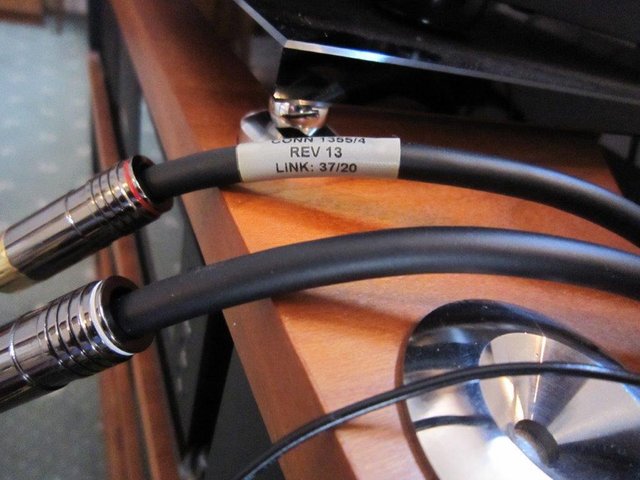
To take the measurements I just unplugged the two phono plugs and the earth lead from the Superline phono stage and using a Fluke 87 got the following readings.
Red Phono inner pin to phono body :- 6.8 Ohms (Right coil resistance)
White Phono inner pin to phono body :- 6.8 Ohms (Left coil resistance)
Thin earth lead to Ekos body and deck plate:- 0.3 Ohms - continuity as expected.
Thin earth lead to Red phono body :- >999 MOhms infinity.
Thin earth lead to White phono body :- >999 MOhms infinity.
Red phono body to White phono body :- >999 MOhms infinity.
I think this proves conclusively that the thin earth lead connects only to the arm earth via the central Din pin and then on to the chassis and is not connected to the two screens.
We can see from the photos in post #14 that the screens are connected at each phono body to the blue signal return but the two screens are most definitely not connected to each other or the thin earth lead.
This now makes perfect sense and is consistent with how @jagdesign made his cable.
I tried to trace where the Excel spread sheet originated but drew a blank.
Just after I posted this I noticed the label reads Rev 13 - could there be 12 other variants ????
I posted the pictures in #14 to help identify how the T Cable was constructed from pictures I had downloaded from the various Linny sites. Unfortunately I cannot now find where I got them from especially the Excel sheet showing a connection truth table which I am now convinced is not very truthful at all.
Having muddied the waters by posting what appears to be an erroneous truth table I too would like to get to the bottom of exactly how the screens are connected.
Of course I have my own LP12 with Mogami T cable to measure but I have been reluctant to touch the deck as it was upgraded with Kore, Karousel, Radikal 2, Ekos SE and Kandid about 6 months ago by you know who of Leicester and I don't want to upset the cable dressing etc.
However, to answer the question of are the screens connected to the centre earth pin of the din plug and each other I realised this could be measured from the two phono plugs and the earth lead by simply unplugging from the pre amp.
Here are some pics of the cable which confirms it is definitely constructed from Mogami 2549 and it bears a sticker with what looks like Linn reference numbers for its build spec which I know was manufactured towards the end of 2020.



To take the measurements I just unplugged the two phono plugs and the earth lead from the Superline phono stage and using a Fluke 87 got the following readings.
Red Phono inner pin to phono body :- 6.8 Ohms (Right coil resistance)
White Phono inner pin to phono body :- 6.8 Ohms (Left coil resistance)
Thin earth lead to Ekos body and deck plate:- 0.3 Ohms - continuity as expected.
Thin earth lead to Red phono body :- >999 MOhms infinity.
Thin earth lead to White phono body :- >999 MOhms infinity.
Red phono body to White phono body :- >999 MOhms infinity.
I think this proves conclusively that the thin earth lead connects only to the arm earth via the central Din pin and then on to the chassis and is not connected to the two screens.
We can see from the photos in post #14 that the screens are connected at each phono body to the blue signal return but the two screens are most definitely not connected to each other or the thin earth lead.
This now makes perfect sense and is consistent with how @jagdesign made his cable.
I tried to trace where the Excel spread sheet originated but drew a blank.
Just after I posted this I noticed the label reads Rev 13 - could there be 12 other variants ????
Excellent work @Cloth Ears, and relieved my screen cutting wasn't too hasty!
The cable (and deck, which was new to me) is still sounding great here
The cable (and deck, which was new to me) is still sounding great here
Paul R
pfm Member
I just got around to looking at my Alphason Xenon MCS. The reason this is relevant is that it is wired with Van den Hul twisted pair and is therefore another bite of a similar cherry. At least I assume that. The wire in the phono plugs looks rather coppery for mono-crystal-silver... Anyway.
The screens are not connected anywhere in the phono plugs, they are connected together with the separate earthing wire in the arm base. This approach makes sense to me. I don't suppose it makes that much difference in the end though.
The screens are not connected anywhere in the phono plugs, they are connected together with the separate earthing wire in the arm base. This approach makes sense to me. I don't suppose it makes that much difference in the end though.
Andrew Ponsford
Member
Which phono plugs are on the Linn T-cable?
Andrew Ponsford
Member
I said in my first post, #10 on this thread, that originally I was going to make a T cable using the Mogami cable for my Ittock but I ended up buying an Ekos SE which came with a Linn supplied Mogami T-cable so I didn't need to in the end.
I posted the pictures in #14 to help identify how the T Cable was constructed from pictures I had downloaded from the various Linny sites. Unfortunately I cannot now find where I got them from especially the Excel sheet showing a connection truth table which I am now convinced is not very truthful at all.
Having muddied the waters by posting what appears to be an erroneous truth table I too would like to get to the bottom of exactly how the screens are connected.
Of course I have my own LP12 with Mogami T cable to measure but I have been reluctant to touch the deck as it was upgraded with Kore, Karousel, Radikal 2, Ekos SE and Kandid about 6 months ago by you know who of Leicester and I don't want to upset the cable dressing etc.
However, to answer the question of are the screens connected to the centre earth pin of the din plug and each other I realised this could be measured from the two phono plugs and the earth lead by simply unplugging from the pre amp.
Here are some pics of the cable which confirms it is definitely constructed from Mogami 2549 and it bears a sticker with what looks like Linn reference numbers for its build spec which I know was manufactured towards the end of 2020.



To take the measurements I just unplugged the two phono plugs and the earth lead from the Superline phono stage and using a Fluke 87 got the following readings.
Red Phono inner pin to phono body :- 6.8 Ohms (Right coil resistance)
White Phono inner pin to phono body :- 6.8 Ohms (Left coil resistance)
Thin earth lead to Ekos body and deck plate:- 0.3 Ohms - continuity as expected.
Thin earth lead to Red phono body :- >999 MOhms infinity.
Thin earth lead to White phono body :- >999 MOhms infinity.
Red phono body to White phono body :- >999 MOhms infinity.
I think this proves conclusively that the thin earth lead connects only to the arm earth via the central Din pin and then on to the chassis and is not connected to the two screens.
We can see from the photos in post #14 that the screens are connected at each phono body to the blue signal return but the two screens are most definitely not connected to each other or the thin earth lead.
This now makes perfect sense and is consistent with how @jagdesign made his cable.
I tried to trace where the Excel spread sheet originated but drew a blank.
Just after I posted this I noticed the label reads Rev 13 - could there be 12 other variants ????
"thin earth lead connects only to the arm earth via the central Din pin and then on to the chassis and is not connected to the two screens."
I am not sure it does prove that. Another way would be if the screens are not connected to the phono bodies which would account for open circuit.
To my mind a better arrangement would be as mentioned in post 36. Phono centre pins to pins 1 and 3, phono bodies to pins 4 and 5 - and no connection of the screens at the phono ends. Long earth lead connected to short chassis tab, pin 2 and both screens. That is, direct connection from phono plugs to cartridge and totally separate earthing. I am just about to make a lead up. This is how I plan to do it unless someone has a better plan.
Craig B
Re:trophile
Linn OEM plugs, likely made by ELKA. Rean (subsidiary of Neutrik) NYS373 (or their RS2C 'Finger Groove' series*) are the best widely available plugs for the money, IME.Which phono plugs are on the Linn T-cable?
* same plug, restyled barrel.
Andrew Ponsford
Member
Thanks.Linn OEM plugs, likely made by ELKA. Rean (subsidiary of Neutrik) NYS373 (or their RS2C 'Finger Groove' series*) are the best widely available plugs for the money, IME.
* same plug, restyled barrel.


